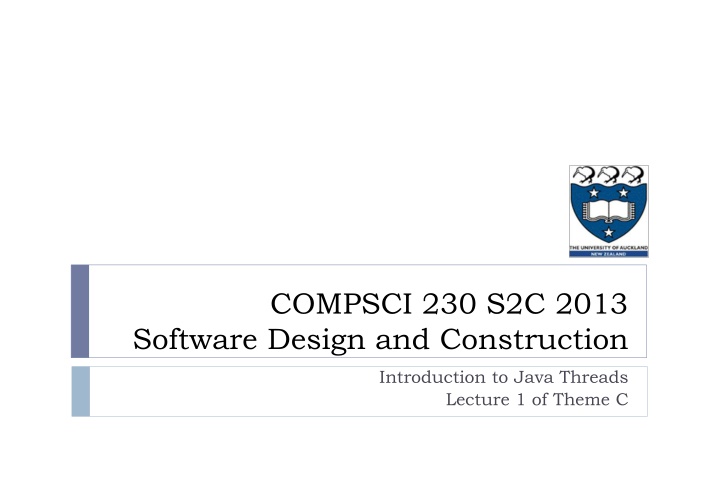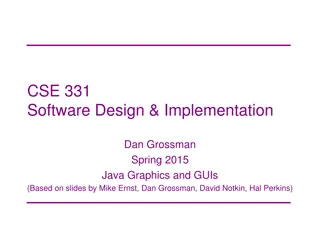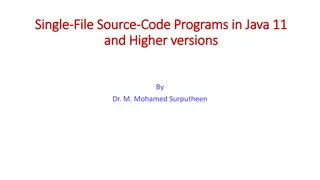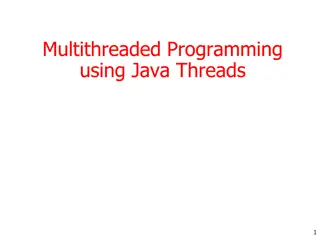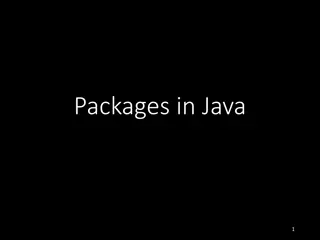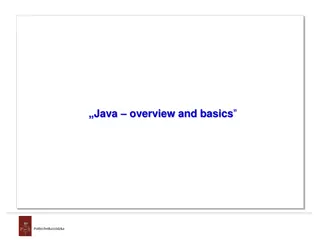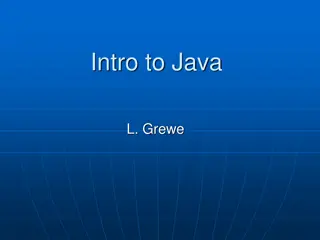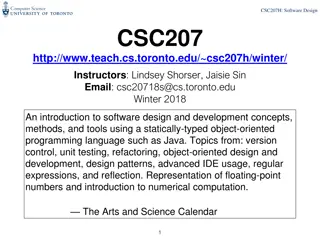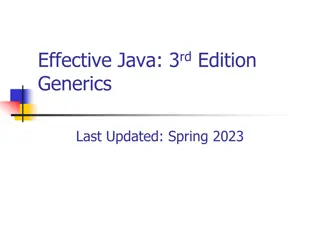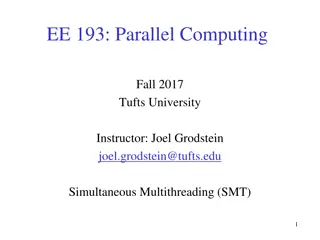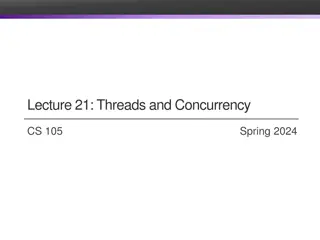Introduction to Java Threads: Software Design and Construction
This content delves into the fundamentals of Java threads in software design and construction. It covers topics such as the lifecycle of threads, synchronization, deadlock, performance considerations, and dealing with exceptions. With a focus on developing a strong mental model for multithreaded programs, understanding the complexities of multithreading, and exploring common design patterns, this material equips learners with essential knowledge to tackle multithreaded computations effectively.
Download Presentation

Please find below an Image/Link to download the presentation.
The content on the website is provided AS IS for your information and personal use only. It may not be sold, licensed, or shared on other websites without obtaining consent from the author.If you encounter any issues during the download, it is possible that the publisher has removed the file from their server.
You are allowed to download the files provided on this website for personal or commercial use, subject to the condition that they are used lawfully. All files are the property of their respective owners.
The content on the website is provided AS IS for your information and personal use only. It may not be sold, licensed, or shared on other websites without obtaining consent from the author.
E N D
Presentation Transcript
COMPSCI 230 S2C 2013 Software Design and Construction Introduction to Java Threads Lecture 1 of Theme C
Lecture Plan for Weeks 10-12 Sikora pp. 157-9, Goetz1 pp. 1-6. 18/5 Introduction to Java threads 21/5 A thread's life Goetz1 pp. 6-10. 22/5 Where Java threads are used; synchronization Goetz1 pp. 10-15. 25/5 Locking, blocking, mutex; visibility, consistency. Goetz1 pp. 15-20. 28/5 Deadlock; performance; programming guidelines. Goetz1 pp. 20-24. 29/5 Dealing with InterruptedException (intro) Goetz2 pp. 1-3. Executors, tasks, concurrent collections, synchronizers. 1/6 Bloch pp. 271-7. 4/6 Concurrency in Swing Oracle Debugging Swing / Revision of this unit 5/6 Potochkin 2 C1
Readings for this unit Strongly recommended! 1. Sikora Zbigniew Sikora, Threads , Chapter 10 of Java: Practical Guide for Programmers, Elsevier, 2003. Available to registered students through our library: http://www.sciencedirect.com.ezproxy.auckland.ac.nz/science/article/pii/B9781558609099500107 2. Goetz1 Brian Goetz, Introduction to Java threads , IBM developerWorks, 26 Sep 2002, 27 pages. Available: http://www.ibm.com/developerworks/java/tutorials/j-threads/j-threads-pdf.pdf 3. Goetz2 Brian Goetz, Java theory and Practice: Dealing with InterruptedException , IBM developerWorks, 23 May 2006. Available: http://www.ibm.com/developerworks/java/library/j-jtp05236/index.html 4. Bloch Joshua Bloch, Concurrency: Prefer executors and tasks to threads, and Prefer concurrency utilities to wait and notify , Items 68 and 69 in Chapter 10 of Effective Java, Prentice Hall, 2nd Edition, 2008. Available to registered students through our library: http://proquestcombo.safaribooksonline.com.ezproxy.auckland.ac.nz/9780137150021 5. Oracle Oracle, Lesson: Concurrency in Swing , The Java Tutorials, 2013. Available: http://docs.oracle.com/javase/tutorial/uiswing/concurrency/initial.html 6. Potochkin Alexander Potochkin, Debugging Swing, the final summary , 16 February 2006. Available: https://weblogs.java.net/blog/alexfromsun/archive/2006/02/debugging_swing.html 3 C1
Learning Goals for Today Develop an appropriate mental model for multithreaded programs. Predict the outputs of a simple multithreaded program. Understand why multithreading is important and difficult! List, and briefly discuss, some of the ways in which multithreading is used in Java. Recognise some common design patterns for multithreaded computations: Model-View-Controller, simulation with one-thread-per- actor, foreground/background computations. Explain how a volatile variable differs from a non-volatile one: what are its advantages and disadvantages? 4 C1
PrintNumbersThread public class PrintNumbersThread extends Thread { String name; public PrintNumbersThread( String threadName ) { name = threadName; } public void run() { for( int i=1; i<=2; i++ ) { System.out.println(name + ": " + i); try { Thread.sleep(500); } catch( InterruptedException e ) { } } } } 5 C1
RunThreads public class RunThreads { public static void main( String args[] ) { PrintNumbersThread threadl; PrintNumbersThread thread2; threadl = new PrintNumbersThread("Threadl"); thread2 = new PrintNumbersThread("Thread2") ; threadl.start () ; thread2.start () ; } } Thread2: 2 Thread1: 2 Thread1: 1 Thread2: 1 Thread2: 1 Thread1: 1 Thread2: 2 Thread1: 2 Thread2: 1 Thread1: 2 Thread1: 1 Thread2: 2 Thread1: 1 Thread2: 1 Thread1: 2 Thread2: 2 Expected output: or Thread1: 1 Thread1: 2 Thread2: 1 Thread2: 2 Thread2: 1 Thread2: 2 Thread1: 1 Thread1: 2 6 C1
Tracing a Threaded Program public class RunThreads { public static void main( String args[] ) { PrintNumbersThread threadl; PrintNumbersThread thread2; threadl = new PrintNumbersThread("Threadl"); thread2 = new PrintNumbersThread("Thread2") ; threadl.start () ; thread2.start () ; } } 1. 2. 3. 4. 5. 6. 7. 8. 9. 10. public class PrintNumbersThread extends Thread { 11. public void run() { 12. for( int i=1; i<3; i++ ) { 13. System.out.println(name + ": " + i); 14. try { Thread.sleep(500); } 15. catch( InterruptedException e ) { } 16. } } } Note that the parent thread dies before its children. Thread1: 1 Thread2: 1 Thread1: 2 Thread2: 2 7 C1
Tracing a Threaded Program (2) public class RunThreads { public static void main( String args[] ) { PrintNumbersThread threadl; PrintNumbersThread thread2; threadl = new PrintNumbersThread("Threadl"); thread2 = new PrintNumbersThread("Thread2") ; threadl.start () ; thread2.start () ; } } 1. 2. 3. 4. 5. 6. 7. 8. 9. 10. public class PrintNumbersThread extends Thread { 11. public void run() { 12. for( int i=1; i<3; i++ ) { 13. System.out.println(name + ": " + i); 14. try { Thread.sleep(500); } 15. catch( InterruptedException e ) { } 16. } } } Note that the threads are unsynchronised. Thread1: 1 Thread2: 1 Thread2: 2 Thread1: 2 8 C1
CPUs, Cores, Processes, Threads Modern computers have many forms of parallelism. In hardware, there are One to four CPU chips, with Two to eight cores per CPU chip, and Hundreds of instructions in the execution pipeline of each core. In software, there are Hundreds of processes, where Each process is either running or waiting (for a core or an I/O device); and One to 20 (or more) threads of control per process. Each thread is either running or waiting. (There are actually four states in Java s thread model, as we ll see later.) If you are hand-executing a multithreaded program, you probably move only one instruction-pointer at a time this is like a single-core execution. If you could move 8 pointers simultaneously, you d be simulating an 8-core CPU. 9 C1
Context Switches When a core switches its context to start executing a different thread, there is significant performance penalty: Very roughly: hundreds of wasted instruction-execution cycles. When you re hand-executing a multi-threaded program, you have to move your hand to a different instruction-pointer before you can start to move it this is your context-switching time. Currently, most CPU cores run only one thread at a time. Ideally: number of runnable threads number of cores. Ideally: each thread runs for a long time (>> 1000 instructions) before it has to wait for the output of another thread, or for an I/O device, or before it is interrupted by the end of its time-slice. Currently, most operating systems have 100 to 1000 time-slices per second. If you have more than 100 threads in a single Java program on a laptop or home computer, your threads will be waiting most of the time. If threads have to wait more than 30 msec, your GUI will probably be jerky and sluggish . 10 C1
Parallelism is difficult, why use it? Because it s there If you write single-threaded Java programs, and your competitors are multi- threading efficiently, their programs will run 3x or even 8x faster because they re using CPU cores that you re leaving idle. This is especially noticeable on CPU-limited computations e.g. image analysis. Note: modern PCs also have a GPU (Graphics Processor Unit), allowing very efficient computer graphics without burdening the CPU. Because it s very convenient When you re writing GUIs, you generally use one thread to render the graphics (the View ), one or more threads to run the back-end computation (the Model ), and one thread (the Controller ) to accept input from the user. If you single-thread a GUI, the controls will be non-responsive and the display will freeze while you re updating the Model (unless your model-updates take 30 milliseconds or less). 11 C1
Why use parallelism? (cont.) Because it s built into the JVM The JVM has some daemon threads which run very helpful services, e.g. its memory garbage collection. In earlier languages, you had to clean up your own garbage by explicitly de- allocating objects. Java collects garbage objects automatically and correctly almost-all of the time, unless you terminate your threads improperly! JVM s daemons are carefully designed to stay out of your way : running only when necessary, making useful progress during a single time-slice, and allowing your program s threads to make progress (on other CPU cores) while the service is actively running . 12 C1
Why use parallelism? (cont.) Because it s natural (in some programs) When simulating a system with many actors, it s natural to have one thread per actor: the thread s run() method describes what this actor does . For example, a traffic simulator might have one thread for each automobile, bus, or truck that is on the roads being simulated. Warning: using parallelism to fit your problem, rather than parallelism to fit your hardware , may lead to very inefficient computations. A desktop PC will not run 10000 threads efficiently, however it can efficiently simulate 10000 automobiles in a roading network (if your simulator uses 100 threads). 13 C1
Why use parallelism? (cont.) Because it s natural (in some programs) In a server program, a thread worker can be assigned to each client. The thread s run() method delivers the service. In a program that handles asynchronous I/O devices (e.g. network interfaces, disks, keyboards) a thread can be assigned to each device. The thread s run() method handles the I/O stream for this device. If the thread executes a blocking read, e.g. SocketInputStream.read(), it will not run again until the read succeeds. The JVM handles this wait very efficiently. 14 C1
Sharing Nicely If your threads don t talk to each other, they can t cooperate. If your threads do talk , they might confuse each other. When one thread is changing an object, the other threads must be prevented from reading this object until the changes are complete. When one thread is accessing a method, other threads must wait their turn (unless the method is thread-safe i.e. it can handle multiple simultaneous accesses). There are several ways to share safely 15 C1
Volatile variables If a variable, object, or field is declared as volatile, then It can be used for reliable communication between threads. Non-volatile variables, objects, and fields have unpredictable semantics, if they are read & written by more than one thread. For example, if Thread1 and Thread2 are both executing the following: int x = 1; System.out.println(name + ": " + ( x++ ) ); This is equivalent to executing: int x = 1; int t = x; t = t + 1; x = t; System.out.println(name + ": " + x ); Thread1: 2 Thread2: 3 16 C1
Volatile variables (2) If a variable, object, or field is declared as volatile, then It can be used for reliable communication between threads. Non-volatile variables, objects, and fields have unpredictable semantics, if they are read & written by more than one thread. For example, if Thread1 and Thread2 are both executing the following: int x = 1; System.out.println(name + ": " + ( x++ ) ); This is equivalent to executing: int x = 1; int t = x; t = t + 1; x = t; System.out.println(name + ": " + x ); Thread1: 2 Thread2: 3 or Thread2: 2 Thread1: 3 17 C1
Volatile variables (3) If a variable, object, or field is declared as volatile, then It can be used for reliable communication between threads. Non-volatile variables, objects, and fields have unpredictable semantics, if they are read & written by more than one thread. For example, if Thread1 and Thread2 are both executing the following: int x = 1; System.out.println(name + ": " + ( x++ ) ); This is equivalent to executing: int x = 1; int t = x; t = t + 1; x = t; System.out.println(name + ": " + x ); Thread1: 2 Thread2: 3 or Thread2: 2 Thread1: 3 or Thread2: 3 Thread1: 2 Thread1: 2 Thread2: 2 Thread1: 3 Thread2: 2or or or Thread2: 2 Thread1: 2 18 C1
Volatile variables (4) If a variable, object, or field is declared as volatile, then It can be used for reliable communication between threads. Semantics are predictable if a thread reads the variable then writes it, the other thread is blocked from reading until the newly-written value is available. Warning: you can cripple a multithreaded program by making all of its variables volatile. The JVM must always read volatiles from memory. Frequently-used non-volatile values are retained in the CPU register file, which is *much* faster than main memory. For example, if Thread1 and Thread2 are both executing the following: volatile int x = 1; System.out.println(name + ": " + ( x++ ) ); Thread1 and Thread2 always get different values! Thread2: 2 Thread1: 3 or Thread1: 2 Thread2: 3 Thread2: 3 Thread1: 2 or Thread1: 3 Thread2: 2 19 C1
Learning Goals for Today Develop an appropriate mental model for multithreaded programs. Predict the outputs of a simple multithreaded program. Understand why multithreading is important and difficult! List, and briefly discuss, some of the ways in which multithreading is used in Java. Recognise some common design patterns for multithreaded computations: Model-View-Controller, simulation with one-thread-per- actor, foreground/background computations. Explain how a volatile variable differs from a non-volatile one: what are its advantages and disadvantages? 20 C1
